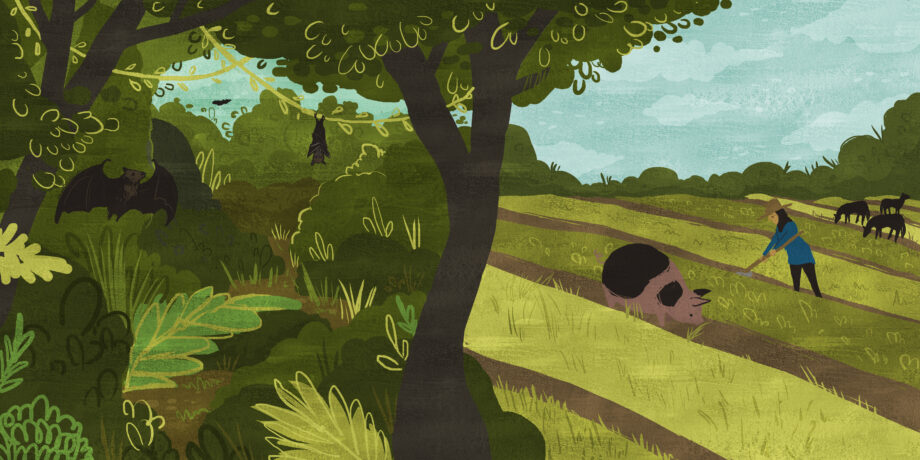October 3, 2016 — What if we could reduce diseases and discover life-saving drugs by conserving natural habitat? Would saving ecosystems become more appealing if human health were on the line?
Well, although an underreported dimension of the destruction of wildlife habitat, human health is exactly what is at stake. Habitat destruction has played a role in the emergence of disease organisms that move between humans and other animals, such as Ebola, and even, some scientists argue, in the increase of incidences of Lyme disease. Loss of habitat has also had the unintended consequence of eliminating access to potentially lifesaving drugs by destroying the very places where those drugs originate.
Whether or not people care about nature for its own sake, these implications for human well-being should galvanize them toward habitat and wildlife conservation, and elevate conservation to the same level of importance as things such as cancer or stem cell research or efforts to eradicate malaria or HIV.
Disease Emergence
Undisturbed, wild animals and their habitats can serve as a barrier preventing the spillover of emerging infectious diseases — EIDs — from animals to humans. Because the diseases and the animals have evolved together, the diseases have little to no effect on those animals. When transmitted to humans, however, those pathogens can result in EIDs. It has been estimated that 60 percent of recent EIDs have been zoonoses, and close to three-quarters of these originated in wildlife. The clearing of undisturbed habitat to pave way for human activities such as agriculture has created blurred boundaries between wild and domestic animals, helping to facilitate the jump to humans.
This is what happened in the cases of Nipah and Hendra viruses, among others. The clearing of forests in Southeast Asia and Australia, respectively, led certain types of flying fox fruit bats to move closer to farm animals (pigs in the case of Nipah; horses in the case of Hendra). The farm animals ate virus-ridden bat saliva or urine, became ill, and transmitted the disease to humans who came into contact with them. Neither virus was new, but both were kept from humans until habitat destruction facilitated the jump.
Zoonotic diseases exact an enormous human toll — identified diseases account for at least 2.7 million deaths and 2.5 billion cases of human sickness annually. In the developing world, zoonotic EIDs can exacerbate other public health challenges, such as lack of infrastructure and malnutrition resulting in increased bushmeat consumption, which can in turn introduce new varieties of EIDs. And zoonotic EIDs can have huge economic and social implications as well, such as loss of employment and business — familiar outcomes during outbreaks. For example, pig farmers in Malaysia incurred a loss of US$244 million during a Nipah outbreak in 1998 and 1999 due to mass culling of pigs.
Almost half of human medicines come directly or indirectly from the natural world, even as less than 10 percent of all of the world’s biodiversity has been evaluated for potential drugs.
Surveillance, detection and responses to these outbreaks are unfortunately low in developing countries, which are often particularly vulnerable to the emergence of EIDs due to their proximity to areas of high biodiversity: As they develop, those countries and their people face higher exposure to zoonotic pathogens. Meanwhile, population density and increased global travel means transmission of these diseases will be effective, even in the developed world.
The tremendous harm zoonotic EIDs wreak globally points to a powerful need to improve our understanding of the role of wildlife ecology and the wildlife-livestock interface in their emergence. Increasing research in this area would offer tremendous benefit by improving our ability to predict which regions are most at risk and to prepare and respond to these threats. The recent surges in EIDs across the world underscore the importance of protecting wildlife habitat, both with speed and in scale.
Nature’s Medicine
And then there’s medication: Almost half of human medicines come directly or indirectly from the natural world, even as less than 10 percent of all of the world’s biodiversity has been evaluated for potential drugs. Many lifesaving drugs, including some recent anti-cancer drugs, have originated in nature.
Yet all of this progress is likely just scratching the surface of nature’s incredible potential to yield health-promoting substances. New species are continually being found. Discoveries of bacteria that survive in the unlikeliest of places have opened possibilities for even more new drug discoveries. And scientists have recently begun tapping into potential drug discoveries from other members of the microbial world, too.
Meanwhile, 60 percent of people worldwide depend almost exclusively on plants for their primary medication. Animals are also used in parts of the developing world for traditional medicines. Yet, we are allowing the natural world to disappear without fully understanding what will be lost — or knowing at all, since we can only assume that some species are becoming extinct before humans even know about them. To protect these current and future sources of medicines, we need to protect the nature that provides them.
Safeguarding Human Life
Studying and conserving nature is as important as any other human health initiative, and the health benefits of conservation need to be included alongside other discussions about saving nature. It is time to make the case that wildlife science and conservation are relevant to everyone’s life. Too many people’s health will be in jeopardy if we don’t. ![]()
Editor’s note: The views expressed here are those of the author and not necessarily of Ensia. We present them to further discussion around important topics. We encourage you to respond with a comment below, following our commenting guidelines, which can be found here. In addition, you might consider submitting a Voices piece of your own. See Ensia’s “Contact” page for submission guidelines.
Rashmi Bhat produced this feature as a participant in the Ensia Mentor Program. Her mentor for the project was David Doody.
Ensia shares solutions-focused stories free of charge through our online magazine and partner media. That means audiences around the world have ready access to stories that can — and do — help them shape a better future. If you value our work, please show your support today.
Yes, I'll support Ensia!

I hope you know how important, informative and arousing your article is. You must get it out to the public, ASAP. People are seeing and hearing now. This is worthy of a Nobel Peace Prize. Congratulations, I am so thankful for your gift to see and then be able to express it so that we can see too. I have noticed that many of our problems would be so easy and simple to fix, but poise a problem in this selfish civilized world. I have also noticed that once people are educated to what is happening, they will make and help others to make changes for the better. I'm sure you are aware of Pope Francis' recent announcement that taking care of Earth is an act of Mercy. Adding all the above with prayer, we will make changes for the better. Keep writing....
First of all, 'nature' is a main source of medicines. Probably yes, although pharmaceutical industry plays a key role. But the medicine argument is a rather old one, and a not very specific one. For human food we know more ore less what species are required, let say about 1000. But how many and what kinds of species do we need for medicine and where can they be found? Probably most of these species are bacteria and lychens, maybe insects. Do we need bacteria from tropical forests or insects from mountain areas? And if we do not want to be that specific, the only thing we can say that we need all nature - because you never know.
The other argument concerns the relationships between natural areas and urban areas. If we destroy parts of the forests for instance, bats or birds have no naural habitats anymore and they will colonize the human world. So we should protect these forests. But more nature can also cause more deseases among humans. Several viruses are spread by birds or mammals because these animals have the opportunity to migrate after the impovement of ecological infrastructure. - by humans. So, here the health argument can be used against nature conservation. And it is used that way. In the Netherlands several citizens' groups oppose against ecological restoration projects, because they fear malaria.
Another argument to protect nature for human helath might be that people feel better in a green environment. There is pretty much evidence for that. But again, this is a very general argument. People feel healthy if they walk or cycle in gardens, parks or rural areas. They also like dunes and beaches, but not vulnerable bogs, for instance. In sum, I do not think the health argument is useless, but it needs specification.